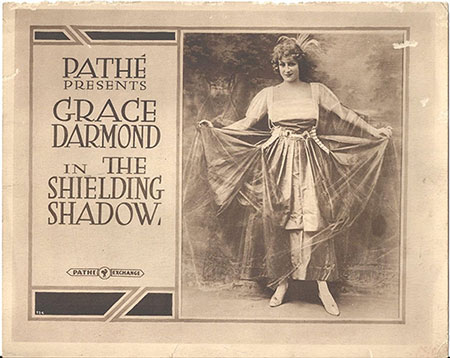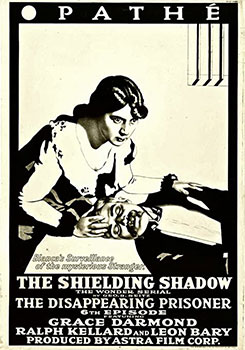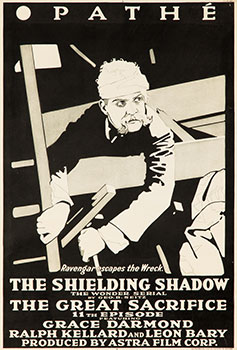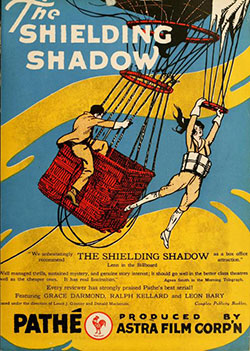S …is for
The Shielding Shadow
Based on a scenario by George Seitz (later novelized by Randall Parrish), The Shielding Shadow was directly inspired by another silent movie serial, Judex (1916), produced by Pathé’s competitor, the French film company Gaumont. The release of Judex (whose first episode was entitled “The Mysterious Shadow”) had been delayed because of World War One, so The Shielding Shadow arrived on American screens first. (The opposite was true in France, where The Shielding Shadow—known by its other title, Ravengar—appeared after Judex.) Both films are thought to have inspired the popular character of “The Shadow.”
The serial was replete with exciting devices, including a skeleton on a ledge, a hot-air balloon that explodes and drops into the sea, and a floating coffin. But the most striking and intriguing device was, of course, the invisibility cloak, which became central to later films such as Invisible Man (1933) and which remains popular even in modern films such as Wonder Woman, Marvel’s The Avengers, and the Harry Potter film franchise. As ads for “The Wonder Serial” The Shielding Shadow insisted: “The tens of millions who speculated as to the identity of the LAUGHING MASK in Pathé’s ‘Iron Claw’ serial will be vastly more at sea” in trying to solve the mysteries of the “Shadow” serial.
Survival Status: According to Treasures from the Film Archive, only a few chapters—4, 10, 11, 14, 15—survive.
Director: Louis J. Gasnier, Donald MacKenzie
Release Date: October 1, 1916
Release Company: Astra Film Corporation, distributed by Pathé Exchange, Incorporated
Cast: Grace Darmond (Leontine), Ralph Kellard (Jerry Carson, also known as Ravengar), Léon Bary (Sebastian Navarro), Madlaine Traverse (Barbara), Lionel Braham (The Bouncer), Frankie Mann (Cabaret Singer), Leslie King (“One Lump” Louie), Hallen Mostyn, Madeline Francine.
Episodes: (two reels each) 1. The Treasure Trove. 2. Into the Depths. 3. The Mystic Defender. 4. The Earthquake. 5. Through Bolted Doors. 6. The Disappearing Shadow. 7. The Awakening. 8. The Haunting Hand. 9. The Incorrigible Captive. 10. The Vanishing Mantle. 11. The Great Sacrifice. 12. The Stolen Shadow. 13. The Hidden Menace. 14. Absolute Black. 15. The Final Chapter.





